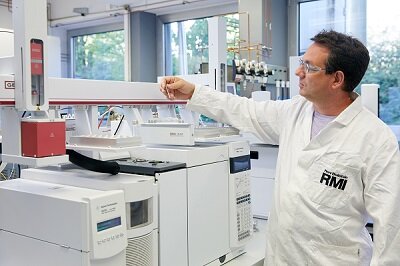In-Can VOC/SVOC Determination by Gas Chromatography (GC)

Since people spend a large part of the day indoors, solvent-free paints are preferred today. The absence of solvents is tested according to ISO 17895 using a gas chromatrographic method.
For this purpose, the samples are tempered in an oven. The volatile organic compounds (VOC) in the interior paints are released and transferred to a gas chromatograph. There they are separated and the VOCs are detected up to 250 °C as a sum parameter by means of flame ionisation detection (FID). The quantification is based on a standard addition analytical method.
Furthermore, the RMI can determine the content of volatile organic compounds (VOC content) and the content of semi-volatile organic compounds (SVOC content) of coating materials according to ISO 11890-2 by gas chromatography. This determination is carried out by liquid injection of the prepared sample into the gas chromatograph and subsequent detection by means of flame ionisation detection (FID) and mass selective detection (MSD).
Environmental analysis: Emission chamber measurement of coatings according to EN 16402
For a healthy living environment, interior paints and other interior coating materials must be low in emissions.
The emissions of indoor coatings can be determined with standardised test chambers according to the European standards EN 16402 for coatings and EN 16516 for building products. The European standards are also based on the international standards ISO 16000-9 (test chamber method), ISO 16000-6 (determination of VOC and SVOC content) and ISO 16000-3 (determination of formaldehyde and acetaldehyde content).
For testing, coating samples are placed in a miniaturised "model room" and air samples are taken at specific time periods, after 3, 7 and 28 days. Volatile organic compounds (VOC) are collected on sorbent material and analysed by gas chromatography. Formaldehyde and acetaldehyde are collected on carrier material (DNPH cartridges) and analysed by liquid chromatography.
The volatile organic compounds are transferred from the sample tube to a gas chromatograph by heating the sample. There, the substances are separated on a chromatographic column and then detected with a mass spectrometric detector. With this time-intensive, but very sensitive method, complex organic compounds can be identified and detected down to trace levels of a billionth of a volume in the air (1 ppb or 1.2 µg per 1 m³ of air). The emissions of products for the German market are then carried out according to the so-called AgBB scheme, an evaluation scheme of the Committee for Health-related Evaluation of Building Product Emissions (AGBB).
* Accredited test



